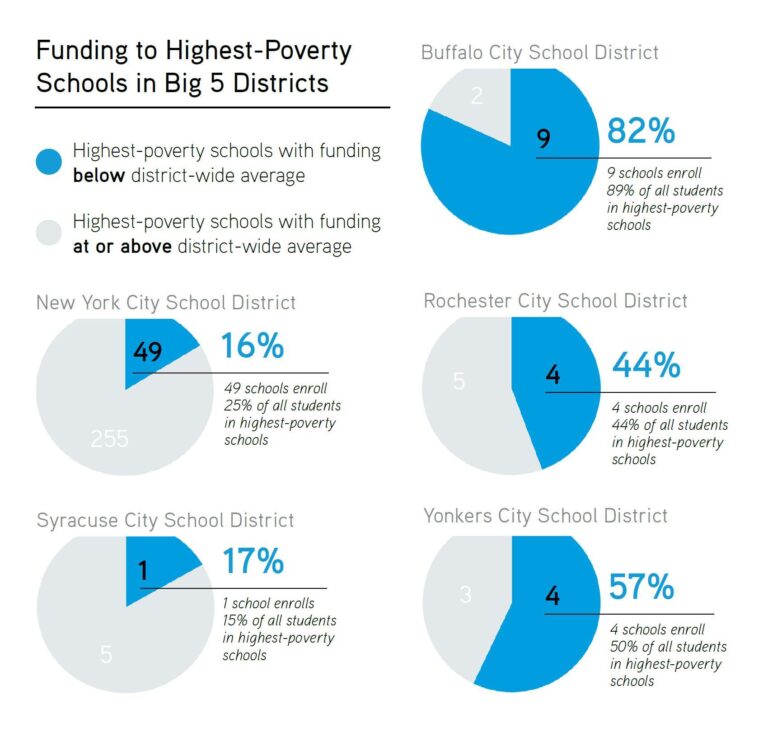New York once again topped the nation in public school spending during the 2020-21 academic year, reaching an all-time high, according to recent data analyzed by the Empire Center for Public Policy.Despite budgetary pressures amid the COVID-19 pandemic, the state’s investment in education outpaced every other state, underscoring ongoing debates about fiscal priorities and the efficiency of school funding across the country. This report offers a detailed look at the figures, their implications, and the challenges facing New York’s education system moving forward.
New York School Spending Reaches Unprecedented Levels in 2020-21
In the fiscal year 2020-21, New York’s investment in public education reached unprecedented heights, surpassing all previous records nationwide. Total expenditure exceeded $80 billion,reflecting a continued commitment to addressing both traditional educational needs and the emergent challenges posed by the pandemic. This surge is attributed to enhanced funding for remote learning infrastructure, increased health and safety measures, and expanded support services for students.
Key factors contributing to this historic spending increase include:
- Technological upgrades: Significant allocations were made to equip students and teachers with necessary devices and high-speed internet access.
- Health protocols: Schools invested heavily in sanitization, personal protective equipment, and facility modifications to ensure safe reopening.
- Support for vulnerable populations: Additional resources targeted at special education, mental health services, and nutritional programs.
| Category | 2020-21 Spending (in billions) | % of Total Budget |
|---|---|---|
| Instruction & Curriculum | $45.2 | 56% |
| Health & Safety | $10.4 | 13% |
| Technology & Infrastructure | $8.7 | 11% |
| Student Support Services | $9.1 | 12% |
| Others | $6.6 | 8% |
Dissecting the Allocation of Funds Across Districts and Programs
Examining the distribution of education funds reveals that spending variations among New York State’s districts are not merely a factor of population size but also reflect differing priorities and challenges each district faces.Wealthier districts tend to allocate more funds toward advanced programs and infrastructure enhancements, while lower-income areas often prioritize basic educational resources and student support services. The disparity is stark, with some districts dedicating upwards of 25% more per pupil than others, illustrating the complexity behind state-wide averages and prompting questions on equitable resource distribution.
At the program level, funds were notably concentrated in several key areas:
- Special Education: The largest share, accommodating diverse learner needs and mandates.
- Teacher Salaries and Benefits: Constitutionally protected,representing a consistent majority of expenditures.
- Technology and Remote Learning: An accelerated investment trend due to pandemic shifts in school operations.
- Extracurricular Activities: Varied widely, reflecting community engagement and local funding capabilities.
| Program Area | Percentage of Total Spend | Notable Trends |
|---|---|---|
| Special Education | 32% | Increasing due to growing enrollment |
| Teacher Salaries & Benefits | 45% | Stable but majority share |
| Technology & Remote Learning | 10% | Sharp rise since 2019 |
| Extracurriculars | 5% | Volatile, dependent on local fundraising |
| Facilities & Maintenance | 8% | Consistent investment |
Impact on Student Outcomes and Equity Concerns in High-Spending Areas
Despite New York State’s record-breaking school expenditures in 2020-21, the translation of these funds into measurable improvements in student performance shows a complex and often disappointing picture. Analysis reveals that even in the highest-spending districts, gains on standardized tests and graduation rates remain stagnant or marginal. This disconnect raises critical questions about resource allocation efficiency and whether the investments are effectively targeted toward classroom needs or administrative overhead.
Moreover, significant equity concerns persist across these affluent school districts. Students from low-income and minority backgrounds frequently do not see proportional benefits from elevated spending levels, highlighting systemic disparities. Key issues include:
- Uneven access to advanced coursework and enrichment programs
- Persistent achievement gaps within well-funded districts
- Resource concentration in non-instructional areas rather than direct student support
| Metric | High-Spending District Avg. | Statewide Avg. | Equity Gap |
|---|---|---|---|
| Graduation Rate (%) | 88 | 83 | 5 |
| Proficiency in Math (%) | 52 | 49 | 3 |
| Proficiency in ELA (%) | 54 | 50 | 4 |
| Low-Income Student Performance Gap | – | – | Significant |
Improving outcomes will require a sharper focus on closing these gaps and ensuring that increased investments prioritize equitable access to high-quality instruction and supports tailored to vulnerable student populations. Without this, high spending risks perpetuating existing disparities rather than fostering genuine educational progress.
Policy Recommendations to Ensure Sustainable and Effective Education Funding
To address the challenges of balancing quality and efficiency in educational funding, policymakers should prioritize targeted resource allocation based on student needs rather than blanket increases. This includes directing funds to underperforming districts and investing in programs that demonstrate measurable improvements in student outcomes. Additionally, enhancing financial transparency at both the state and local level will ensure taxpayers understand where their money is going, fostering greater accountability and encouraging smarter spending decisions.
Equally important is the implementation of sustainable funding formulas that adjust for inflation,enrollment shifts,and changing demographics. A flexible, data-driven approach allows for responsiveness without sudden budget spikes that strain state coffers. Consider the following key strategies:
- Establishing performance-based grants that reward districts for clear academic progress.
- Encouraging public-private partnerships to supplement traditional funding in innovative ways.
- Utilizing rigorous spending reviews to identify and eliminate inefficiencies.
| Strategy | Expected Outcome |
|---|---|
| Performance-Based Grants | Boosts student achievements and accountability |
| Public-Private Partnerships | Enhances innovation and resource diversity |
| Spending Reviews | Reduces waste and optimizes resource use |
The Conclusion
As New York continues to lead the nation in school spending, reaching an unprecedented peak in the 2020-21 fiscal year, the findings from the Empire Center for Public Policy underscore ongoing debates over education funding and fiscal priorities. With education budgets ballooning despite demographic shifts and evolving economic conditions, policymakers and stakeholders face mounting pressure to ensure that increased expenditures translate into measurable improvements in student outcomes. The report serves as a critical reminder that while spending levels are record-breaking, the ultimate measure of success lies in delivering quality education for all New York students.




